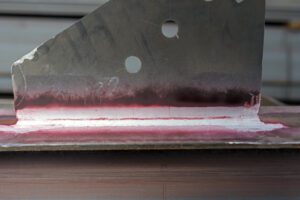Hadd-co offers liquid penetrant inspection for your project. Nondestructive inspection methods, liquid penetrant inspection has both advantages and disadvantages. The primary advantages and disadvantages when compared to other NDE methods are summarized below.
Primary Advantages
- The method has high sensitivity to small surface discontinuities.
- The method has few material limitations, i.e. metallic and nonmetallic, magnetic and nonmagnetic, and conductive and nonconductive materials may be inspected.
- Large areas and large volumes of parts/materials can be inspected rapidly and at low cost.
- Parts with complex geometric shapes are routinely inspected.
- Indications are produced directly on the surface of the part and constitute a visual representation of the flaw.
- Aerosol spray cans make penetrant materials very portable.
- Penetrant materials and associated equipment are relatively inexpensive.
Primary Disadvantages
- Only surface breaking defects can be detected.
- Only materials with a relatively nonporous surface can be inspected.
- Precleaning is critical since contaminants can mask defects.
- Metal smearing from machining, grinding, and grit or vapor blasting must be
removed prior to Liquid Penetrant Inspection. - The inspector must have direct access to the surface being inspected.
- Surface finish and roughness can affect inspection sensitivity.
- Multiple process operations must be performed and controlled.
- Post cleaning of acceptable parts or materials is required.
- Chemical handling and proper disposal is required.
Contact us for more information about Liquid Penetrant Inspection.

